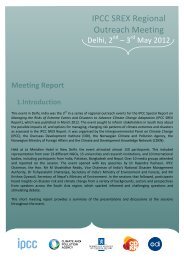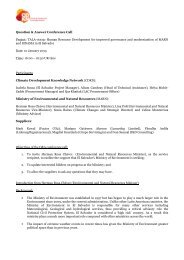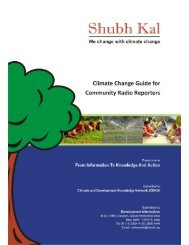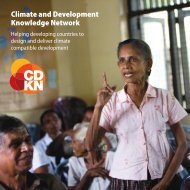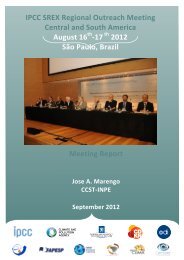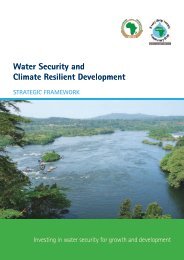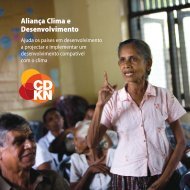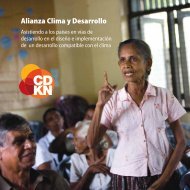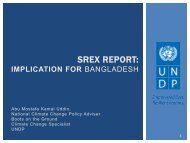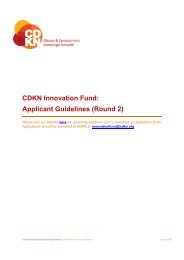Implementation Plan - CDKN Global
Implementation Plan - CDKN Global
Implementation Plan - CDKN Global
- No tags were found...
Create successful ePaper yourself
Turn your PDF publications into a flip-book with our unique Google optimized e-Paper software.
Box 3: VulnerabilityDespite some recent improvements in management and conservation, the region’s coral reefs and associatedmarine ecosystems now face major challenges as a consequence of climate impacts. The slow and steadyincreases in global sea surface temperatures and ocean acidification are already adversely affecting theregion’s coral biome. Because current sea surface temperatures are near the upper temperature thresholdsfor survival of corals, bleaching is predicted to become more frequent as ocean temperatures increase(Hoegh-Guldberg, O. 1999). (F i gure 4)Corals are extremely sensitive to even small changes in water temperature that lead to bleaching andultimately death. A lower pH also reduces the viability of corals. A combined effect of coral reef disappearanceand increases in extreme weather events can pose further threats to already stressed ecosystems. Indicatorsof decline in the coral biome include: a) a reduction in fisheries annual catch, coral cover, and in coastalmangroves; b) encroachment in coastal beach area and coastal lagoons thus affecting the value of theservices provided by the reef; and c) severe coral mortality induced by warmer sea surface temperatures;and d) increasing acidity. As these impacts become more manifest the region’s social and economicdevelopment will continue to be negatively impacted with the most vulnerable groups placed at the greatestrisk. The impacts on the tourism sector and Caribbean economies will be severe. The loss of the coral reefswill significantly increase the risks to essential infrastructure, utilities, and urban areas from storm surge.Figure 4. Frequency of future bleaching events in the 2030s and 2050s (WRI, 2011).Frequency(Percent ofYears) of NOAABleanching AlertLevel 2 Events0 - 1011 - 2121 - 3031 - 4041 - 5051 - 6061 - 7071 - 8081 - 9091 - 100Source: Adapted from Donner S.D. 2009 “Coping with Commitment: Projected thermal stress on coral reefsunder different future scenarios”. PLoS ONE 4(6): e5712 for use in the Reefs at Risk Revisited project.Coral ReefsThe map depicts the frequency of future bleaching events in the 2030s and 2050s, as represented by thepercentage of years in each decade where a NOAA Bleaching Alert Level 2 (i.e. severe thermal stress) ispredicted to occur. Predictions are based on an IPCC A1B emissions scenario and adjusted to account forhistorical temperature variability, but not adjusted by any other resistance or resilience factors.Figure adapted by WRI (2011) from: Donner, S.D. 2009. “Coping with commitment: Projected thermal stresson coral reefs under different future scenarios.” PLoS ONE 4(6): e5712



